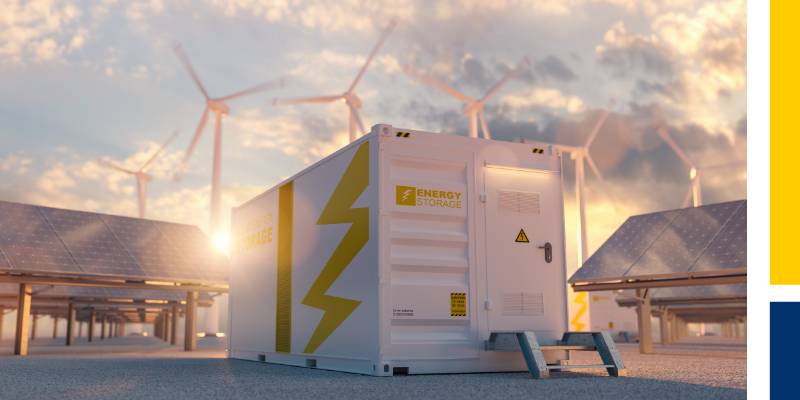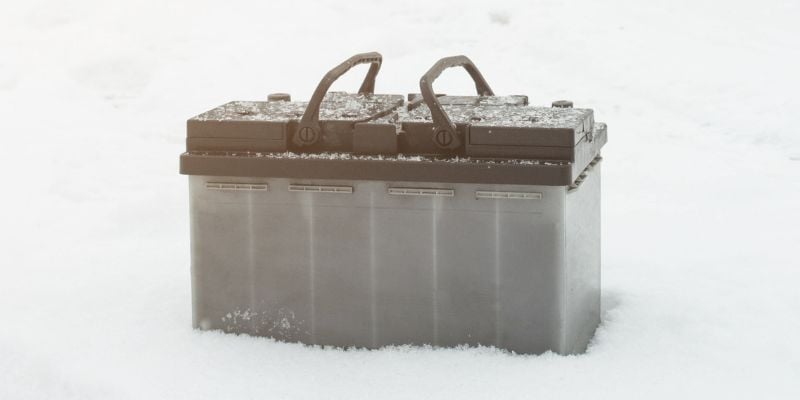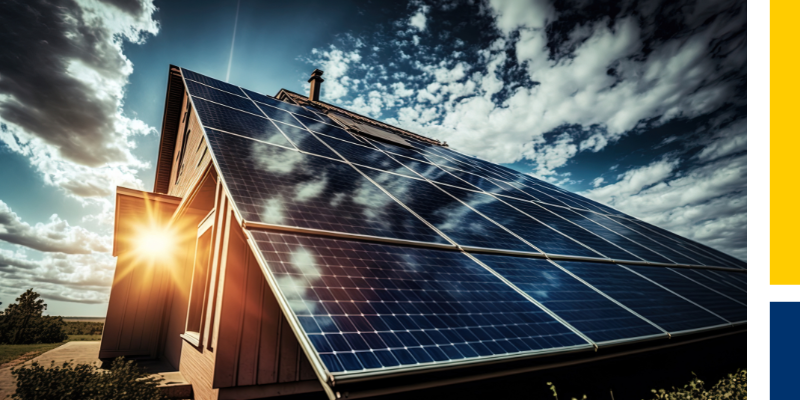Large-scale energy storage can reduce your operating costs and carbon emissions – while increasing your energy reliability and independence…
… if you know what to look for.
We’ve distilled our findings from thousands of large-scale energy storage projects, from North America’s biggest off-grid school to Central Asia’s largest microgrid.
Here’s what you’ll discover:
- Why large-scale energy storage?
- How to boost efficiency and reduce your battery needs
- Tips to pick the right system designer or installer
- Battery Selection 101
- Avoid undersized batteries – and oversized prices
- Simple strategies to install batteries properly
- Maintenance, simplified
- Save time: How to get expert tech support and faster shipping
- And more
Why large-scale energy storage?
More companies, governments, and individuals are storing energy to:
- Reduce their carbon footprints – and power electric vehicles, heat and cool with heat pumps, and more.
- Eliminate or decrease the costs, noise, and emissions of backup generators.
- Store renewable energy for use later – when there’s no sunlight or wind, or when electricity from the grid is pricey.
- Avoid Time of Use (TOU) rates – higher electric rates when peak demand increases the cost of energy generation.
- Ensure adequate backup power to protect against brownouts, blackouts, and inclement weather.
- Go entirely off-grid to save money, increase reliability, or reduce emissions.
Focus on efficiency – and avoid oversized energy storage
Efficiency pays you back every day, whether you’re off-grid or grid-tied or the power grid doesn’t accept your solar or battery production.
To get the most from your system, focus on the basics.
Remove parasitic loads
In households, wasted energy from equipment in “standby” can consume more than 20% of total energy.
Commercial settings are often plagued by hidden energy waste, too.
That’s low-hanging fruit for energy savings.
You can identify vampire loads with plug-in devices like the Kill-A-Watt. Consider options such as the Sense Energy Monitor for larger loads or a more comprehensive overview.
Hire an energy auditor
Ask for a full inspection, including blower door testing and thermal imaging.
This will help:
- Reveal inefficiencies and wasted energy
- Prioritize efficiency projects for your building(s)
- Ensure you can track improvements
Air-seal first, then insulate
Air-sealing buildings prevents temperature exfiltration and infiltration.
Insulation slows the transfer of temperature.
Together, they’re critical to ensuring that energy isn’t wasted on climate control – and minimizing HVAC expenses and temperature swings.
Upgrade energy-wasting equipment that:
- Gets frequent use
- Is old and inefficient
- Guzzles power – especially during business hours, if you’re grid-tied and operate on time-of-use
For instance, heating and cooling are often significant culprits in commercial and residential buildings. To reduce your electrical needs, look into heat pumps, passive and nighttime cooling strategies, and other energy-efficient equipment.
For more about energy efficiency, see:
- North American Energy’s Living the Dream of Net-Zero Energy & Storage case study
- Green Building Advisor
- “The Homeowner’s Guide to Renewable Energy” by Dan Chiras
- “Musings of An Energy Nerd” by Martin Holladay
- And “The Visual Handbook of Energy Conservation” by Charlie Wing
Pick your system designer or installer carefully
Your designer/installer can make or break your batteries’ long-term performance, ROI, and lifespan.
Ask whether your energy-storage installer can provide the following:
- Proof of ongoing training, recertification, and continuing education
- Testimonials and recommendations
- Relevant insurance
- Specifics about their warranty
- Detailed, written estimates
If you design or install large-scale energy systems, consider educating your clients on why the details above are critical for them.
Trusted battery experts or installers will help you design and size your system. They’ll discuss your power loads and usage patterns. They’ll ensure you have power reserves for likely and worst-case scenarios. And they’ll ensure you don’t over- or under-purchase on storage (and solar or wind power).
Battery Selection 101
No battery is perfect, and every application is different.
Your key considerations include:
- Uptime and reliability
- Budget
- Lifetime ROI/cost
- Sustainability
- Maintenance needs
- Operating temperatures and other conditions
- Surge capacity
- Risk tolerance
- Operating habits
Recyclable flooded lead (FLA) batteries dominate large-scale energy storage because of their ROI, safety, recyclability (99% according to the US EPA), ease of installation, and lifespan. They require ventilation and limited routine maintenance, including watering.
Maintenance-free absorbent glass mat (AGM) batteries offer near-zero maintenance, albeit at a higher price point.
Crown’s FLA and AGM batteries are engineered and robotically assembled at our Fremont, OH, USA headquarters. There, trained technicians and AI-powered inspection systems ensure product quality and consistency. (Read “Advances in Battery Manufacturing” when comparison-shopping batteries.)
Lithium-ion (LI) batteries offer near-zero maintenance and higher energy density, often at 3X the cost of recyclable FLA batteries. LI’s energy density can lead to thermal runaway.
For an in-depth look at the pros and cons of batteries, see North American Clean Energy’s “Find the Battery You Need.”
Finally, if you hear an aggressive lifespan claim, be sure you get proof:
- “How did you calculate lifespan?”
- “Do your lifespan claims come from real-world field testing – or simulated laboratory results?” (For instance, “ten-year” batteries should have a decade of field use.)
- “Can you share your test results with me?”
- If the company is a startup, “Is your warranty protected by a third-party insurer?”
Avoid undersized batteries – and apples-to-oranges comparisons
All batteries need reserve power – a safety margin that:
- Ensures stable voltage
- Powers high-wattage loads
- Keeps electricity flowing when there’s no sun, wind, or grid power
- Protects batteries from over-discharging, which compromises longevity and reliability.
The problem:
Some battery companies are 3-4X or more expensive than others.
And some salespeople push undersized battery banks – inadequate, smaller batteries – so their prices seem more reasonable.
Here’s how to protect yourself:
- Know your Depth of Discharge (DoD). This measurement tells you how much battery you can use without harming its lifespan. (For example, an 80% DoD rating means a battery could be cycled until only 20% of its energy remains. But you may risk losing surge capacity, damaging the battery, or running out of power.)
- If you’re off-grid, consider specifying 3-5 battery days of storage – depending on expected sunlight and wind.
- System installers recommend 2X true Amp-hours to avoid downtime and battery damage.
- Ensure your system designer specifies 50% DoD – in writing, not verbally.
Install batteries properly
Batteries last longer when they’re correctly sized, protected from the elements, and meet relevant electrical codes.
Get the details right, for instance:
- Specify Type 316 Stainless Steel for bolts, washers, and nuts. This steel is less likely to corrode and is rugged and inexpensive.
- Coat terminals, lugs, nuts, and bolts with a non-hardening sealant.
- Properly size cables to avoid system failures, heat, and fires. Online wire gauge calculators guide you through the process.
- Look into battery management systems (BMS) to increase capacity and lifespan (by alerting you to problems early). Useful features include measuring voltage (total and per-cell), DoD, and temperature.
- Consider remote monitoring systems that interface with BMS. They give you early warning, often on your cellphone or a website. And they can identify high-electricity loads, spot failing equipment, manage loads (heating, cooling, generators, etc.), and even allow technicians to troubleshoot and adjust inverters and other components remotely.
Protect batteries from extreme temperatures and the outdoors:
- Install batteries in enclosed, well-ventilated, insulated structures – never directly on the floor. Moderate temperatures improve lifespan.
- See National Electrical Code, Article 480.9(A) to ensure you meet all ventilation standards.
- To cool batteries, consider passive methods like stack effect ventilation and/or active methods such as fans, air-conditioning, or nighttime air exchange.
- Don’t install batteries near spark-producing devices like water heaters, electrical outlets, or breakers.
- Keep dry chemical fire extinguishers nearby.
- Double-check that your smoke detectors are working properly and interconnected.
Simplify maintenance
All large-scale energy storage systems require maintenance.
Here’s how to make it easier:
- Show why maintenance is essential: More uptime, longer lifespan, reduced costs
- Schedule regular inspections and maintenance in the calendar.
- Provide proper tools: Keep personal protective equipment (PPE), maintenance tools, and cleaning supplies on hand and easily accessible.
- Document maintenance procedures and post them next to your battery bank. Your battery manufacturer should provide instructions – and answer your questions.
- Create a sign-off sheet to confirm inspections are completed correctly and track maintenance.
If you’re using recyclable FLA batteries, consider investing in:
- Built-in watering systems that automatically fill batteries, eliminating most of the time spent watering.
- Portable watering systems like backpack sprayers or wheelable units filled with distilled water – to slash maintenance time. Consult your battery manufacturer for recommendations.
Save time with expert tech support and fast deliveries
Outsourced tech support and lowest-bidder freight = downtime, wasted hours on the phone and in the field, and mistakes.
Look for battery companies that:
- Deliver in-house tech support with ongoing training and certification
- Specialize in large-scale energy storage
- Provide detailed spec sheets – to simplify permit-pulling and prevent costly revisits and failed inspections.
- Create in-depth documentation on best practices
- Invest in on-site training centers: For instance, Crown Battery’s Commercial Service Center offers 1-3 day hands-on training courses. The 38,000-square-foot facility includes one-stop training on best practices for maintenance, installation, sales, and more.
Ensure you get fast shipping – choose a short, sustainable supply chain:
The longer a battery manufacturer’s supply chain, the higher your risk of delays.
Crown Battery primarily sources domestic, recycled raw materials. That reduces wait times and improves delivery times, sustainability, and employee safety.
Find out more here: How to Protect Your Supply Chain and Mitigate Interruptions.
What’s next:
For more on improving system efficiency with a microgrid with AC coupling, read Remote charter school gets a renewable retrofit (Solar Power World).
If you have questions about setting up your large-scale energy storage system












